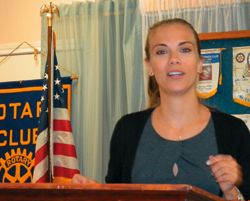

HIGHLANDS Jackie Young and her parents lived in Highlands for many years, from 2003 to 2011, until they determined that their health was at risk from toxins in their well water. Their house was previously owned by the Smitherman family, at the north end of Main Street.
As a result, Jackie is now working for TexansTogether, an activist group headquartered in Austin, dealing with public issues such as the environment, education, and voters rights.
Jackie told her story, and an update on activities around the Waste Pits in the San Jacinto River, to the Highlands Rotary Club at their luncheon on August 19th.
She told how her family, especially her father and herself, became sick with seizures and lesions. Even the pets were sick, she said. The family was forced to quit using well water, and import a fresh supply. When they did that, their health improved.
Her plight was recently told in a full page editorial cartoon by Houston Chronicle artist Nick Anderson, who has championed her story and cause.
Jackie went on to get an environmental geology degree from the University of Houston. Her focus since then has been on the toxic waste pits in the San Jacinto River, and their potential danger to the publics health.
Although the waste pits may not have affected her well water (she says the source is problematic), she says the Highlands area has 4 Superfund sites nearby, and there is a high rate of illness in areas such as Highlands, Channelview, and Baytown.
It is known that the waste pits contain dioxin and furans, which can enter the body through breathing, absorption, and eating and drinking. The are known to cause various types of cancers and other diseases, she said.
Working with TexansTogether and the San Jacinto River Coalition, she wants to have the toxic wastes removed from the site permanently. She said this is one of six solutions now being studied by the federal EPA and the Corps of Engineers. A final decision is due in 2015.
Other actions EPA is considering:
1. No Action
2. Control & Monitoring
3. Cap with upgrade
4. Partial solidification in place.
5. Partial removal (25%)
6. Full removal. This would require 16 months, and cost $100 to $635 million to remove 208,000 cubic yards.

